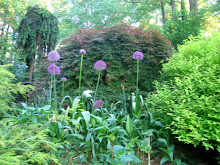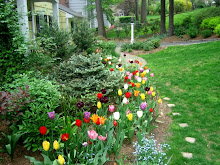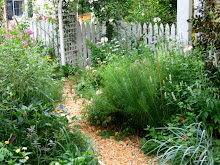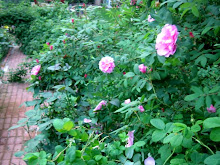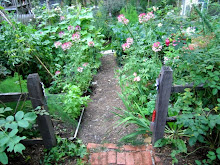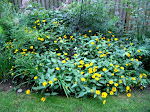
Welcome to Heirloom Gardener
Wednesday, February 25, 2009
Snowdrops (Galanthus elwesii) Blooming in Late February in New Jersey (Zone 6b)
Posted by
Julia Erickson
at
10:18 AM
11
comments
![]()
![]()
Labels: Bulbs and Tubers, Winter Garden
Friday, February 20, 2009
The Most Influential Garden Bloggers
Bumblebee Blog has a very interesting post on the most influential garden bloggers. I read the post with great interest because what is influential or inspiring is so personal. I was nodding my head as she walked through many of the most popular and familiar gardening blogs, so it got me thinking about which garden bloggers have been most influential to me? Here were the top three that came to mind:
1. Gardening Gone Wild: A group effort, Gardening Gone Wild inspires by their posts and encourages me to thoughtfully contribute to their monthly Garden Bloggers' Design Workshop. I love participating in these workshops and reading about how other bloggers approach gardening topics and design issues. Some of my best and most popular posts have been contributions to these workshops.
2. May Dreams Garden: Shortly after I started reading gardening blogs, I noticed this regular post called Garden Bloggers' Bloom Day. I'm a little slow, so it took me a while that this was the brainchild of Carol over at May Dreams Garden. Perhaps more than any other garden blogging activity, this really brings the garden blogging community together to share what is blooming in their garden on the fifteenth of every month. Since I started adding my own Bloom Day posts last year, I haven't missed a month.
3. Gardening Tips 'N' Ideas/Blotanical: Both websites are managed by Stuart in Australia and have been influential to me by opening up my eyes to the many gardening blogs throughout the world that I would never have found on my own.
Posted by
Julia Erickson
at
6:00 AM
2
comments
![]()
![]()
Wednesday, February 18, 2009
Ask Heirloom Gardener: How to Prune an Old, Neglected Rose
One of the unexpected responses to starting Heirloom Gardener is the questions I receive from readers about their gardens. Given how interesting I have found the inquiries, I thought I'd start sharing some of them with all of you. If you have a question for me, email me at heirloomgardener[at]aol[dot]com.
Question for Heirloom Gardener: I just read, and very much enjoyed, your series about pruning roses. Thank you. I've inherited a rose bush that is about 70 years old. It has some huge, gnarly growth at the bottom, from which is growing a horrible mess of old, twisted, and rubbing branches. The rose has been neglected for years, and what I have to deal with is a basic framework of very old growth supporting a mess of spindly young growth. So my question is whether this rose would be injured by being cut back to little more than its basic framework. I fear that such old branches might not like my demand that they be responsible for new canes again after years of playing a supporting role.
Heirloom Gardener's Answer: You don't want to shock the rose too much, so I'd prune it back over a two year time period. In my zone (6b), I would prune it back by one third in April. You may also remove one third of the canes from the ground. After it blooms in the summer, you can prune away any new growth. In the fall, bring it back to the height it was in the spring. The next year, repeat the process. Best wishes.
Posted by
Julia Erickson
at
6:00 AM
2
comments
![]()
![]()
Labels: Pruning and Maintenance, Roses
Monday, February 16, 2009
Twelve Great Nurseries for Heirloom Plants: Roses, Perennials, Annuals, Bulbs and Seeds
In the past year or so that I have been writing this blog, it's been my pleasure to mention a number of the wonderful nurseries which specialize in heirloom plants. Given how frequently that I am asked about where you can buy rare plants, I thought it might be helpful to gather all of the recommendations in a single post. I am sure that this list excludes many fine nurseries, but these are just from my own personal experience. Feel free to make additional recommendations in the comments, as I am always looking for new nurseries. The following list is in no particular order:
1. Antique Rose Emporium (mentioned as a source for various roses in 12/07, 1/08, 2/08, 6/08, and 12/08): http://www.antiqueroseemporium.com/ "Antique Rose Emporium is your source for antique and old garden roses."
2. Ashdown Roses (referred to as a source for a great DVD on 3/08 and roses on 12/08): http://www.ashdownroses.com/ "The best antique, climbing and garden roses."
3. Rogue Valley Roses (mentioned as a source of roses on 12/08): http://roguevalleyroses.com/ "Specializing in antique, rare and exceptional roses."
4. Perennial Pleasures (noted as a source of phlox in 1/08, of cranesbill gernaiums in 5/08 and sweet pea in 8/08, sells perennials): http://www.perennialpleasures.net/ "We grow over 900 varieties of flowers, herbs and shrubs, specializing in heirloom and medicinal plants."
5. Geraniaceae (mentioned in 5/08 as a source for some cranesbill geraniums, specialty geranium nursery): http://www.geraniaceae.com/ "Geraniaceae is a small nursery in Marin County, California (Zone 9b) specializing in some of the plants of the Geranium family."
6. Select Seeds (cited in 2/08 as a source of some of my self seeders, sells annuals, perennials and bulbs): http://www.selectseeds.com/ "...offers gardeners a fabulous selection of unique, high-quality flower seeds and plants, specializing in old-fashioned fragrant varieties, flowering vines, and rare cottage garden annuals."
7. Annie's Annuals & Perennials (source of heirloom annuals and some perennials, noted in 3/08 as an inspiration for my terrarium): http://www.anniesannuals.com/ "Rare, unusual annuals & perennial plants, including cottage garden heirlooms & hard to find California native wildflowers"
8. Old House Gardens (subject of a post on 1/08, with a focus on heirloom dahlias; mentioned as a source of winter aconite in 11/08, dahlias in 9/08, lilies in 8/08, and tulips in 5/08): http://www.oldhousegardens.com/ "Antique Flower Bulbs for Every Garden - Unique, Endangered, Amazing!"
9. Well Sweep Herb Farm (subject of a visit and post in 5/08, sells perennials and herbs): http://www.wellsweep.com/ "Our farm, a family endeavor, is located in the picturesque mountains of Warren County and is home to one of the largest collections of herbs and perennials in the country."
10. Baker Creek Heirloom Seeds (subject of a post in 1/09): http://rareseeds.com/ "Preserving our gardening heritage, offering over 1275 unique varieties!"
11. Seed Saver's Exchange (mentioned in 4/08 as a source of heirloom seeds): http://www.seedsavers.org/ "Since 1975, Seed Savers Exchange members have passed on approximately one million samples of rare garden seeds to other gardeners. We are a non-profit organization of gardeners dedicated to saving and sharing heirloom seeds."
12. Thomas Jefferson's Monticello (indicated in 4/08 as a source of heirloom seeds, also sells a limited selection of heirloom plants): http://www.monticello.org/ "The gardens at Monticello were a botanic showpiece, a source of food, and an experimental laboratory of ornamental and useful plants from around the world."
Posted by
Julia Erickson
at
10:00 PM
5
comments
![]()
![]()
Labels: Nurseries
Sunday, February 15, 2009
Pets in the Garden: Five Reasons Why Cats Are Great for Gardeners
 This month's Garden Bloggers' Design Workshop at Gardening Gone Wild is on Pets in the Garden. Of course, I think I have the best cat in the world, but who doesn't think their pet is the greatest? His name is Luna (yes, a little feminine for a tom cat, but we first thought he was a she). For anyone who has any question about whether cats are good for gardeners, here are five reasons why I think cats are perfect for gardeners:
This month's Garden Bloggers' Design Workshop at Gardening Gone Wild is on Pets in the Garden. Of course, I think I have the best cat in the world, but who doesn't think their pet is the greatest? His name is Luna (yes, a little feminine for a tom cat, but we first thought he was a she). For anyone who has any question about whether cats are good for gardeners, here are five reasons why I think cats are perfect for gardeners:
1. Pest Control. My cat has significantly reduced the number of pests in the garden. He is about 18 months old and as he has grown older, his prey has grown larger--he started with small field mice and voles, moved up to chipmunks, and recently caught a squirrel. And for each one he catches, I am sure he scares off many more. I'm hoping he can catch or at least scare off the rabbits, though I'm afraid the groundhog is wishful thinking.
2. Companionship. When out in the garden, my cat follows me around. He quietly observes what I am doing and then wanders off, but always come back.
3. Gentleness. Unlike those other four legged pets that like run through and dig in the beds, my cat is very, very gentle. Yes, he does occasionally chew on some of the ornamental grasses, but pretty much leaves everything else alone.
4. Litter Box Trained. My cat is litter box trained and goes into the house when he has to go. While I've never noticed any unwanted deliveries in the garden, we do keep a cover on the sandbox, just to be safe.
5. Child Friendly. Of course, my children love the cat and the cat is quite friendly with them. He lets them hold him and pet him and doesn't even mind when my toddler tries to boss him around.
Posted by
Julia Erickson
at
10:03 PM
10
comments
![]()
![]()
Saturday, February 14, 2009
Garden Bloggers' Bloom Day February 2009: Picture of Forced Magnolia Branches

Posted by
Julia Erickson
at
6:47 PM
11
comments
![]()
![]()
Sunday, February 08, 2009
Pictures of House Wren, Goldfinch, Tufted Titmouse and Downy Woodpecker Bird Nests from the Garden
One of the many things that I enjoy about being a gardener is the opportunity for my family to observe all of the native wildlife close-up, particularly the birds. In preparation for spring, we cleaned out all of the bird houses and nesting boxes around the yard and it is so amazing to see how each type of bird nest is made of different materials from the garden. Here are a few of the nests that we found and my best guesses on who made them:



Posted by
Julia Erickson
at
12:09 PM
8
comments
![]()
![]()
Labels: Wildlife in the Garden
Wednesday, February 04, 2009
More Gardening Project Ideas: 10 Inventions From the Garden Shed
If you like to make things for your garden, check out this post, "10 Inventions From the Garden Shed" from Gardening Tips 'N' Ideas. Stuart writes: "Well, it seems that gardeners are no slouches either when it comes to inventing 'stuff' - stuff that might save you money, make a gardening task seem more enjoyable, or turn unwanted resources into a masterpiece. The level of genius required is not mensa-like but it does seem that these individuals have the ability to see outside the box." I was flattered to see that my humble planting square made the list. Thank you Stuart!
Posted by
Julia Erickson
at
5:09 PM
4
comments
![]()
![]()
Labels: Online Gardening Resources
Monday, February 02, 2009
Calendar For Forcing Branches: When to Cut Various Flowering Branches for Forcing
By February, my home is devoid of lingering Christmas decorations and most of my forced bulbs are done. At this point, I turn to the outside once again to bring a little bit of spring into the house: I begin forcing various branches from the garden.
~
I try to cut branches at least the diameter of a dime in mid afternoon when it's warmest. I immediately place the branches in warm water with a floral additive. You can also make the floral additive with a little bleach, sugar, and lemon juice. For a half gallon of water, I would add 4 tablespoons of lemon, 2 tablespoons of sugar, and 1/2 teaspoon bleach. The closer to the natural bloom time the more quickly branches will force.
~
During February and early March, I go out about every seven to ten days for branches. My order of forcing is generally as follows:
~
Forsythia (can be started from early January)
~ Pussywillow (pictured)
Pussywillow (pictured)
~
Red twig dogwood
 Ceris 'Forest Pansy' (pictured)
Ceris 'Forest Pansy' (pictured)
Flowering Pear
Amelanchier (last year started 28 February)

Bridal Wreath Spirea
Flowering Dogwood~
Related posts:
~
Forced Branches: Quince, Crabapple, Willow, Ceris, Dogwood, and Forsythia
~
Cut Flowers, Branches and Foliage: Bringing Early Spring into the Home
~
Forced Branches and Bulbs: Forsythia, Hyacinth, Tulips, Muscari and Crocus
Posted by
Julia Erickson
at
5:41 PM
8
comments
![]()
![]()
Labels: Cut and Forced Flowers
Search Heirloom Gardener
Labels
- About Blogging
- Annuals/Biennials and Perennials
- Autumn Garden
- Books and Movies
- Botanical Gardens
- Bulbs and Tubers
- Children's Garden
- Chrysanthemum
- Clematis
- Container Gardening
- Crocus tommasiniasus roseus
- Cut and Forced Flowers
- Cutting and Rose Gardens
- Dahlias
- Deep Thoughts About Gardening
- Egg Garden
- Fences Arbors Walls and Paths
- Floral arrangements
- Front Border
- Fun Stories About Gardening
- Garden Bloggers' Bloom Day
- Garden Bloggers' Design Workshop
- Garden Planning
- Gardening Blogs
- Gardening Tools and Structures
- Gardening with Children
- Goldberry Hill
- Heirloom and Organic Food
- Hibiscus
- Holidays
- Hydrangeas
- Japanese Beautyberry
- Lilies
- Mixed Borders
- New Jersey / Local Interest
- Nurseries
- Online Gardening Resources
- Peonies
- Pest Control
- Picture This Photo Contest
- Piet Oudolf
- Poppies
- Propagation and Seeds
- Pruning and Maintenance
- Roses
- Seed Heads
- Self Seeders
- Shrubs
- Spring Garden
- Summer Garden
- Trees
- Wildlife in the Garden
- Winter Garden
- Zinia
Blog Archive
-
▼
2009
(257)
-
▼
February
(9)
- Snowdrops (Galanthus elwesii) Blooming in Late Feb...
- The Most Influential Garden Bloggers
- Ask Heirloom Gardener: How to Prune an Old, Negle...
- Twelve Great Nurseries for Heirloom Plants: Roses...
- Pets in the Garden: Five Reasons Why Cats Are Gre...
- Garden Bloggers' Bloom Day February 2009: Picture...
- Pictures of House Wren, Goldfinch, Tufted Titmouse...
- More Gardening Project Ideas: 10 Inventions From ...
- Calendar For Forcing Branches: When to Cut Variou...
-
▼
February
(9)












